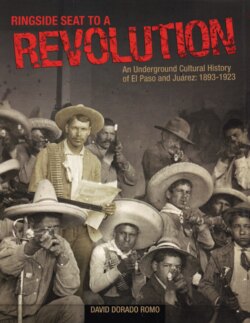Читать книгу Ringside Seat to a Revolution - David Dorado Romo - Страница 37
На сайте Литреса книга снята с продажи.
Оглавлениеthat they’re capable of changing the route of an entire
solar system with their gravitational force.”54 It exhor-
ed its readers towards political unity using the example
of atomic theory and the greater force subatomic parti-
cles possess when they are united. A section of the
publication also examined the phenomenon of astral
projection.
But the underlying motif of Aguirre’s metaphysical-
cal-revolutionary book was that Teresita, with her
extraordinary lightness of being, was the only woman
capable of taking Mexico to a higher spiritual plane.
Revolution, for Aguirre, was a collective form of
astral projection.
IN THE SUMMER of 1892,
Lauro joined Teresita and 12
members of the Urrea fami-
ly in Nogales, Arizona,
after Porfirio Díaz had
forced Teresita into
exile. Immediately,
Aguirre began publish-
ing El Independiente
from there. He found-
ed the newspaper
together with Richard
Johnson, an American
radical, and Manuel
Flores Chapa, a Mexican
revolutionary who had for-
merly collaborated with
Catarino Garza’s rebellion car-
ried out by a group that called
itself “libres fronterizos” (free
bordermen) in South Texas.
The news of the massacre
of Tomóchic in October 1892
radicalized Lauro Aguirre. It
spurred him to call for armed
insurrection. Before this, like the Tomóchic villagers
themselves, he had believed in taking up arms only in
self-defense. After the massacre, Aguirre changed his
mind. He now believed that both offense and defense
were necessary in the struggle against Díaz. Like Cruz
Chávez, the leader of the Tomóchic rebels, he had for-
merly opposed the killing of his enemies once they
were disarmed. Now, he saw things differently. “The
Mexican authorities are thieves and assassins,” Aguirre
wrote in a letter to a Teresista rebel after the massacre.
“Show no compassion towards them. They show none
towards us.”55
In early 1893, Aguirre met with a group of people
at the Urrea home to draft a revolutionary manifesto
called “El Plan de Tomóchic.”56 The manifesto
denounced the massacre of Tomóchic as well as the
war of extermination that the Mexican government was
waging against the Yaqui Indians. It accused the feder-
al army of murdering thousands of innocent Yaqui
men, women and children and selling those who had
survived into slavery. It called for the restora-
tion of the Liberal Constitution of 1857,
which guaranteed the freedom of
press and religion. One of the
Plan de Tomóchic’s clauses—
that was very uncommon
for its time and place—
demanded absolute
equality before the
law for both men and
women. The mani-
festo was for the
abolishment of “all
laws or social prac-
tices that maintains
inequality based on
gender, race, nationali-
ty or class.” It called for
new legislation “declar-
ing both men and women,
whites and blacks, natives
and foreigners, rich and poor,
have the same rights, duties
and privileges and that they be
absolutely equal before the
law.”57 Finally, the Plan de
Tomóchic, called for an armed
revolution against the “the
tyranny of Porfirio Díaz.”
Nine men and seven women signed the Plan de
Tomóchic including Teresita’s faithful companion,
Mariana Avendaño.58 Neither Teresita, Lauro Aguirre or
Tomás Urrea signed the document due to heavy gov-
ernment surveillance. Arizona agents hired by
Chihuahuan governor Miguel Ahumada, however,
reported that these three were the Plan de Tomóchic’s
true authors.
32
Teresita, her father Tomás, her stepmother Gabriela
(holding the baby) and her siblings, ca. 1896.
Photograph by J. Burges. (Southwest Collection,
Texas Tech University.)
54
Aguirre and Urrea, Tomóchic, p. 128.
55
Osorio, Tomóchic en llamas, p. 193.
56
It was also called the “Plan for the Restoration of the Reformist Constitution.”
57
The Teresista plan is included in its entirety in Osorio’s Tomóchic en Llamas, pp. 397-389.
58
One of the signatures—that of Tomás Esceverri—may have been Don Tomás’ pseudonym. His wife’s maiden name was Esceverri.
